In the lesser-known public gardens of Western North Carolina, bamboo bursts from the soil, maple trees shade walls of stone and sculptures rise from the earth. From the grounds of a 19th century inn to a whimsical West Asheville plot, our region offers the chance to experience the same sense of wonder that filled 10-year-old Mary Lennox when she turned a rusty key in an old gate and discovered the world of the classic children’s book The Secret Garden.
Whether you encounter a half-wild grove of branches and vines or a proper English garden fit for a king, the feeling of amazement is the same, full of hidden passageways and surprising plants. You just need to know where to look. Go beyond the manicured pathways with this guide to a few of the region’s best-kept garden secrets.
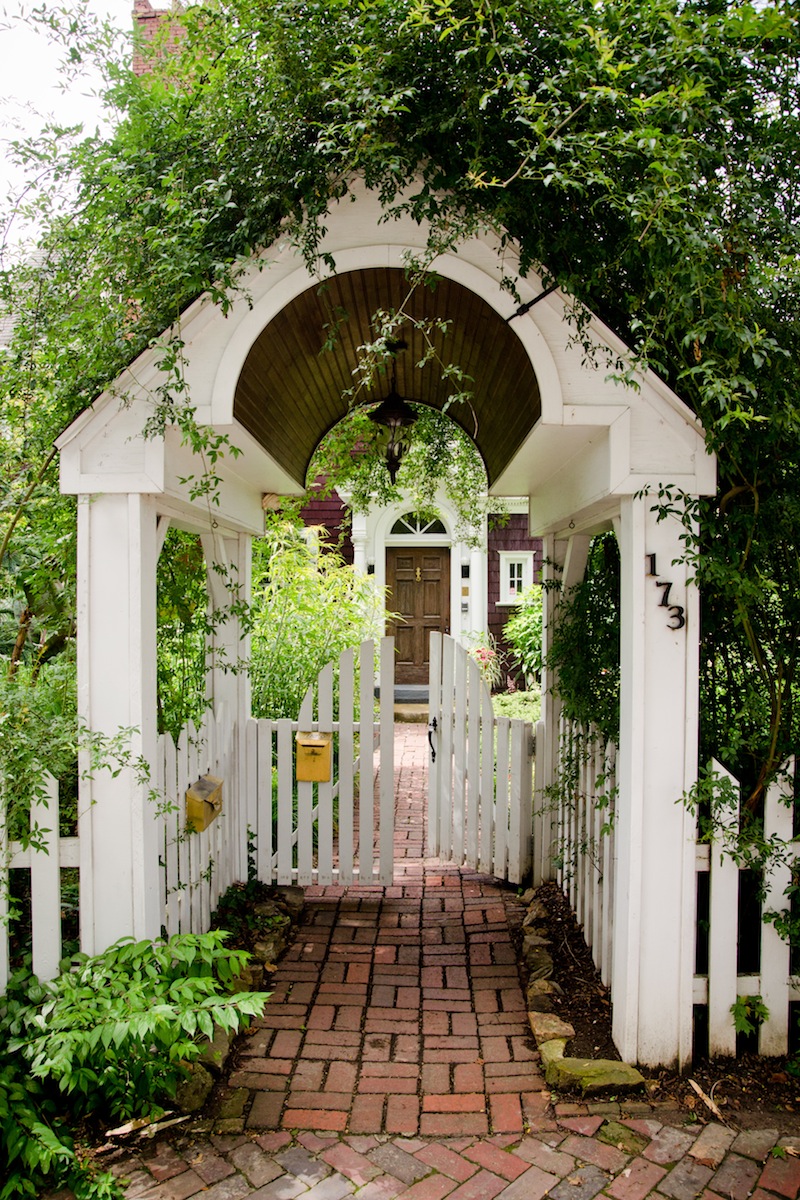
Open the gate
It’s hard to resist the intimate coves and dense greenery of the 1889 WhiteGate Inn & Cottage near downtown Asheville. The gardens got a modern update when Ralph Coffey and partner Frank Salvo bought it in 1999. Coffey moved approximately 450 of his favorite perennials and shrubs from Lake Norman, near Charlotte, to create the inn’s backyard garden where once there was just an expanse of grass. Conifers, red-veined begonias and flowering hibiscus line the bed-and-breakfast’s meandering paths, and cozy sitting areas create an elaborate maze that lure casual visitors like a Siren’s call.
Coffey invites visitors to experience a “kaleidoscope of color where you don’t have to do anything but enjoy.” The experience is different each season, with pinks and lavender in the spring, vibrant greens in the summer and a display of yellows, oranges and reds in the fall.
The garden also lends its own botanical tunes: One of the garden’s most startling plants is Euphorbia stricta, a small biennial with seedpods that make a snapping sound when they pop open. “What I love about the garden itself is just the different textures, shapes and colors of the trees and conifers and how all that blends together,” Coffey says.
The public is welcome to wander through the garden, though the grounds are designed primarily for the inn’s guests, he explains. There’s no need to make an appointment, but if you want to see the inn’s greenhouse, which contains approximately 1,500 orchids and tropical plants, it’s best to call ahead, Coffey mentions.
He’s also happy to guide visitors through the stone walkways, pointing out distinctive plants and water features. Each unique tree and flower makes this centrally located, yet lushly private, utopia the perfect place to start your secret garden tour. whitegate.net, 173 E. Chestnut St., Asheville.
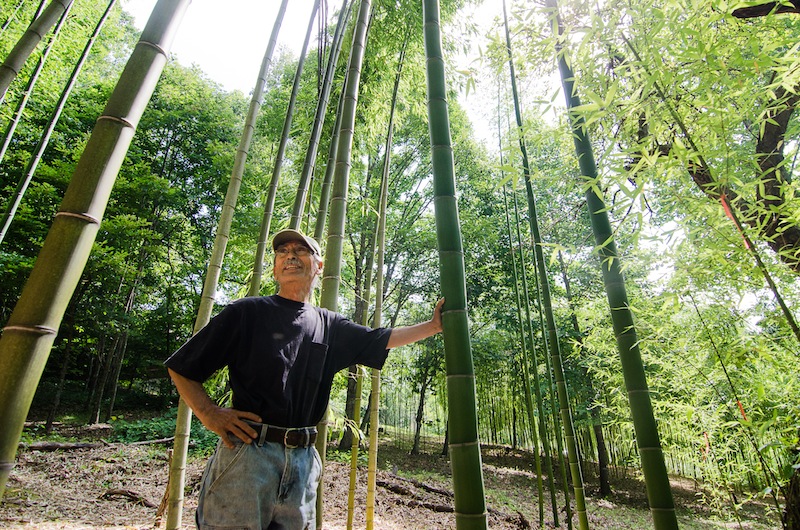
A trip to Japan
(no plane ticket required)
Bamboo, that king of grasses, whispers in the breeze at Haiku Bamboo Nursery in Hendersonville. The sounds intoxicate and transport visitors to another world. Dried leaves crunch underfoot. A creek, mighty with summer rain, rushes through the back of the property. The air seems cooler. Some of the stalks are 60 feet tall and 12 inches around.
Keiji Oshima, who owns the nursery with his wife Stephani, leads visitors through this dense, 6-acre forest. He stretches his hands around a thick green stalk. The leaf canopy quivers when Keiji shakes the trunk. “Look at that. Just 60 days,” he says with a gentle glee.
Keiji speaks with a halting Japanese accent, full of punctuated silences. The bamboo sways above him as he pauses to choose the right word. His quiet nature fits the spirit of the nursery’s regular tours, which can attract as many as 30 visitors per outing. “When they walk through the forest, no more speak,” he says in a whisper.
Bamboo-seekers come to the nursery’s classes from as far away as California or Massachusetts. When they do break the silence, Keiji says, they are surprised by the way the leaves rustle in the wind. “First time the tourists come, they say ‘wow’ when they hear the sounds.”
Stephani adds that visitors sometimes applaud when they see the giant timber bamboo for the first time.
The grove makes for more than a beautiful walking experience. With approximately 50 handmade knives to choose from, Keiji crafts nearly everything out of bamboo — from flutes to baskets to toys. Smaller stalks, which can be as thin as a pencil, are best for baskets, while the timber bamboo makes for excellent fencing. Creative students have constructed bamboo bikes and lofty sculptures at what the Oshimas say is the only bamboo school in the country.
Keiji also says that the best way to enjoy the bamboo forest is with a lawn chair and a cold beer. He feels relaxed when he enters the forest, and visitors are invited to experience the same sense of calm. “They are happy because I’m happy too,” he says.
The Oshimas prefer that visitors attend a scheduled, 90-minute walking tour rather than stop by unannounced. Tours depart from the warehouse on the second and fourth Sundays of each month in spring, summer and fall. Visitors may also make an appointment to pick out bamboo they’d like to buy. Keiji will dig it up on the spot and answer questions about these mighty grasses. haikubamboonursery.net, 20 Tuttle Road, Hendersonville.
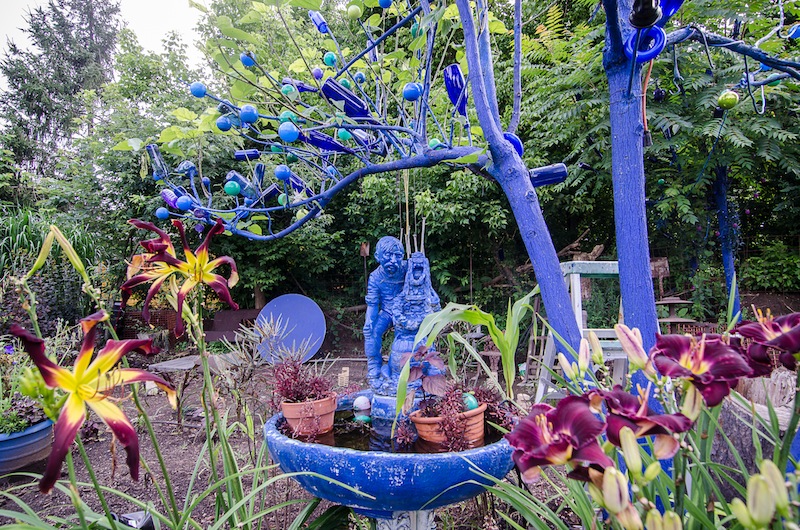
Morticia’s paradise
With its dark purple trees and blue poppies, Christopher D. Mello’s West Asheville garden is a gothic haven. Over the past decade, he has selected the inkiest hues for plants and features in this plot of the unusual —radiating rows of clover and vintage toy trucks give the garden a whimsical, yet slightly Addams Family feel.
And a row of shovels — handles stuck in the ground, blades pointing to the sky like Stonehenge — can be seen from the street, along with bottle sculptures and other plants that would make Morticia Addams and her macabre family proud.
No gate separates the garden from West Asheville’s busy streets. It’s tucked behind an auto shop, around the corner from Harvest Records and not far from West Asheville Lounge and Kitchen. “Hardcore gardeners are going to poke their heads in and come in,” says Mello. He sees the property’s lack of signs and gates as a “bravery filter” that tempts adventurous visitors into crossing a permeable threshold, though he says he likes to meet visitors before they make themselves at home.
A remote visit is possible, if you’re feeling timid: Mello hopes to make the garden visible from outer space, or more conveniently, Google Earth. He says a “modern-day narcissism” drives him to make his property so distinctive that anyone with a satellite, or access to a 3-D mapping program, can enjoy it.
“I’m trying to get everything in the garden to be either really bizarre or really fragrant or really purple,” says Mello. Once he achieves these deep swaths of color, he imagines the property as a home for equally creative performance art. He hopes to host dance parties or perhaps theater-in-the-round productions on a stage made from Tinkertoys or Lincoln Logs.
Mello’s garden has no formal name or website, although he occasionally posts a “Christopher’s Garden” sign that can be seen from the street. Look for the blue and red bottles peeking out from above the hedges at the corner of Westwood Place and Waynesville Avenue in West Asheville. The garden is private property, however, so be respectful and stick to daytime visits. Catch Mello with a shovel in his hand for an impromptu tour.
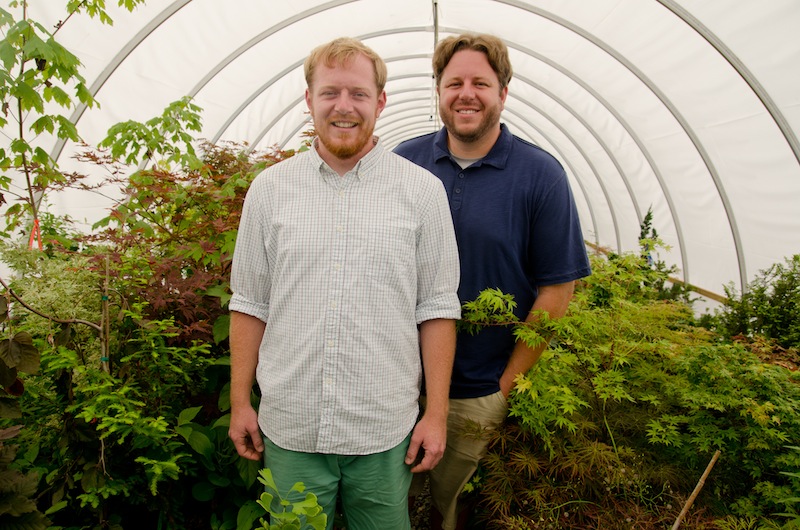
Meet the tree geeks
Nichols Nursery provides a world where 1,000 different cultivars of Japanese maple trees stretch out their limbs and beckon garden-hunters into the greenhouse. Norman Nichols, the original “Mr. Maple” of the family, started this wonderland of maples 40 years ago as a hobby, and many of his original trees still sway in the wind.
Six years ago, sons Matt and Tim Nichols took over the nursery and made the business official. The family’s homestead serves as the hub of the farm, with a formal Japanese maple garden in front and rows of greenhouses to the side.
Each greenhouse bursts with a lush array of maples and Ginkgo trees, lined up by the thousands. “Here’s a kagero, and this is a tamin nishiki,” says Matt, who bellows as he weaves under and around limbs and leaves, and ducks into each of the nursery’s many greenhouses. “They’re probably some of the rarest in the world,” he declares. Both brothers are self-proclaimed tree geeks who rattle off complicated Japanese names with a Southern drawl.
The brothers regularly welcome visitors from as far away as New Jersey. Maple lovers flock to their East Flat Rock nursery to pick out the perfect sapling. “Folks just kind of make a vacation out of coming to this area and picking up some new trees,” says Matt.
The Nichols travel, too, trekking to Belgium and England to view international gardens and speak at conferences. These adventures spark their creativity and passion for delicate Japanese maples. With some advance notice, they’re happy to share this knowledge with visitors from near and far. “Folks are welcome to give us a call and come out to see the whole operation,” says Matt.
“Mr. Maple” (which, these days, could mean either brother) travels to dozens of garden shows each year, hauling a 33-foot trailer packed with trees behind them. You’ll often find them grafting maples on an additional property a few miles down the road from the family’s homestead. To view some of the most unusual Japanese maples in the world, give them a call or send an email before stopping by. mrmaple.com or 551-6739, East Flat Rock.
How to (really) see a garden
So you’ve made it out to one of WNC’s secret gardens. You’re standing at the gate, about to enter, but what do you look for? Experiencing a garden can be its own art form, and it’s up to each viewer to fully appreciate the beauty.
Linda Alford, a Buncombe County Extension master gardener volunteer, suggests thinking about whether you feel delighted, calm, serene or excited as you walk inside. Then celebrate the gardener’s imagination by focusing on the entire space rather than one interesting plant.
As you take it all in, spend a moment thinking about how the garden is composed and what draws your eye, as you would when walking through an art museum. But unlike a painting or photograph, viewing a garden is a 3-D, full-sensory experience. No artist guides your eye to the left or right; it’s up to you to let the plants and trees guide you, she says.
Share the secret
Whether it’s the grand Biltmore Estate, the North Carolina Arboretum or one of the many smaller public gardens in WNC, the best way to enjoy them is to follow the owner through hidden passageways and around unusual plants. Or ask the gardener to let you take a peek inside. Chances are, they will enchant you with a tour and share tips for improving your own garden.
While the adventure will be full of discoveries, don’t let your visit be a surprise to private garden owners. Be sure to call ahead. Then take a moment to engage the gardener and let them share the beauty that grows behind the gate.
Once you find these treasures, let the rest of us in on the secret. Tell your friends, family, maybe strangers and Xpress. Point out masterpieces of bamboo, Japanese maple, daylilies, tulips and sculpture as you pass by.
Who knows, maybe you’ll find the key to a hidden garden with many of the lush botanicals that make our region such a wondrous place to live.



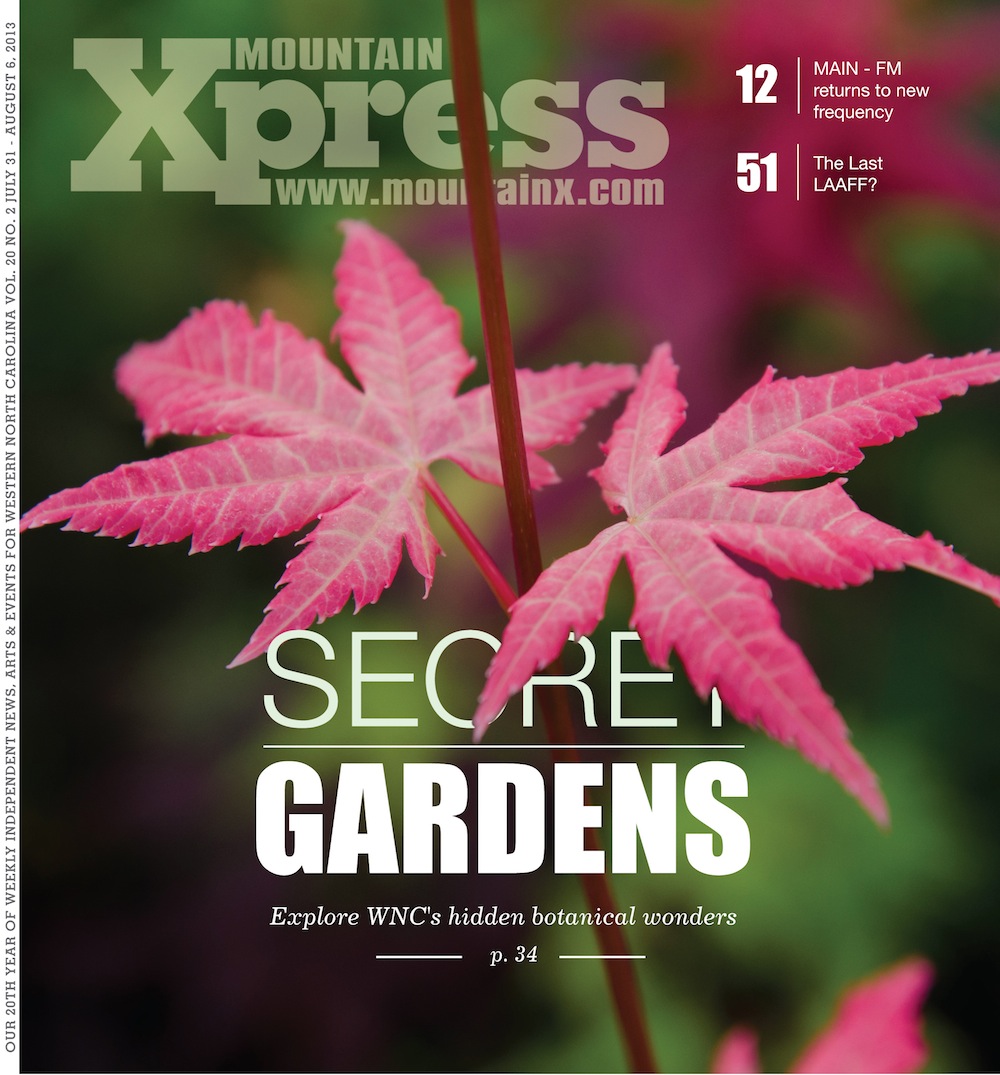
Before you comment
The comments section is here to provide a platform for civil dialogue on the issues we face together as a local community. Xpress is committed to offering this platform for all voices, but when the tone of the discussion gets nasty or strays off topic, we believe many people choose not to participate. Xpress editors are determined to moderate comments to ensure a constructive interchange is maintained. All comments judged not to be in keeping with the spirit of civil discourse will be removed and repeat violators will be banned. See here for our terms of service. Thank you for being part of this effort to promote respectful discussion.